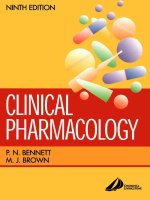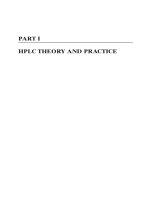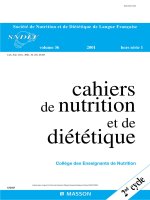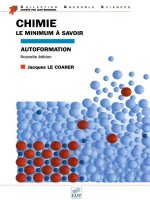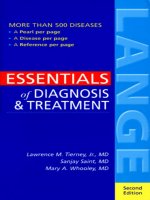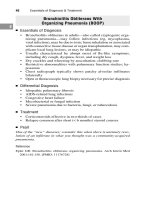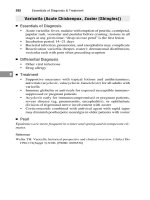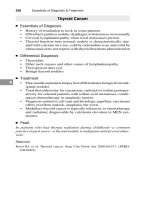DIAGNOSIS & TREATMENT - PART 1 docx
Bạn đang xem bản rút gọn của tài liệu. Xem và tải ngay bản đầy đủ của tài liệu tại đây (479.03 KB, 54 trang )
Essentials of
DIAGNOSIS & TREATMENT
This page intentionally left blank.
Second Edition
a LANGE medical book
Lawrence M. Tierney, Jr., MD
Professor of Medicine
University of California, San Francisco
Associate Chief of Medical Services
Veterans Affairs Medical Center
San Francisco, California
Sanjay Saint, MD, MPH
Assistant Professor of Medicine
Division of General Medicine
University of Michigan Medical School
Research Scientist
Ann Arbor Veterans Affairs Medical Center
Ann Arbor, Michigan
Mary A. Whooley, MD
Assistant Professor of Medicine
University of California, San Francisco
Section of General Internal Medicine
Veterans Affairs Medical Center
San Francisco, California
Lange Medical Books/McGraw-Hill
Medical Publishing Division
New York Chicago San Francisco Lisbon London Madrid
Mexico City Milan New Delhi San Juan Seoul Singapore
Sydney Toronto
Essentials of
DIAGNOSIS & TREATMENT
Copyright © 2002 by The McGraw-Hill Companies,Inc. All rights reserved. Manufactured in
the United States of America. Except as permitted under the United States Copyright Act of
1976, no part of this publication may be reproduced or distributed in any form or by any
means, or stored in a database or retrieval system, without the prior written permission of the
publisher.
0-07-139500-8
The material in this eBook also appears in the print version of this title: 0-07-137826-X.
All trademarks are trademarks of their respective owners. Rather than put a trademark sym-
bol after every occurrence of a trademarked name, we use names in an editorial fashion only,
and to the benefit of the trademark owner, with no intention of infringement of the trade-
mark. Where such designations appear in this book, they have been printed with initial caps.
McGraw-Hill eBooks are available at special quantity discounts to use as premiums and
sales promotions, or for use in corporate training programs. For more information, please
contact George Hoare, Special Sales, at or (212) 904-4069.
TERMS OF USE
This is a copyrighted work and The McGraw-Hill Companies, Inc. (“McGraw-Hill”) and its
licensors reserve all rights in and to the work. Use of this work is subject to these terms.
Except as permitted under the Copyright Act of 1976 and the right to store and retrieve one
copy of the work, you may not decompile, disassemble, reverse engineer, reproduce, modi-
fy, create derivative works based upon, transmit, distribute, disseminate, sell, publish or sub-
license the work or any part of it without McGraw-Hill’s prior consent. You may use the
work for your own noncommercial and personal use; any other use of the work is strictly
prohibited. Your right to use the work may be terminated if you fail to comply with these
terms.
THE WORK IS PROVIDED “AS IS”. McGRAW-HILL AND ITS LICENSORS MAKE
NO GUARANTEES OR WARRANTIES AS TO THE ACCURACY, ADEQUACY OR
COMPLETENESS OF OR RESULTS TO BE OBTAINED FROM USING THE WORK,
INCLUDING ANY INFORMATION THAT CAN BE ACCESSED THROUGH THE
WORK VIA HYPERLINK OR OTHERWISE, AND EXPRESSLY DISCLAIM ANY WAR-
RANTY, EXPRESS OR IMPLIED, INCLUDING BUT NOT LIMITED TO IMPLIED
WARRANTIES OF MERCHANTABILITY OR FITNESS FOR A PARTICULAR PUR-
POSE. McGraw-Hill and its licensors do not warrant or guarantee that the functions con-
tained in the work will meet your requirements or that its operation will be uninterrupted or
error free. Neither McGraw-Hill nor its licensors shall be liable to you or anyone else for
any inaccuracy, error or omission, regardless of cause, in the work or for any damages result-
ing therefrom. McGraw-Hill has no responsibility for the content of any information
accessed through the work. Under no circumstances shall McGraw-Hill and/or its licensors
be liable for any indirect, incidental, special, punitive, consequential or similar damages that
result from the use of or inability to use the work, even if any of them has been advised of
the possibility of such damages. This limitation of liability shall apply to any claim or cause
whatsoever whether such claim or cause arises in contract, tort or otherwise.
DOI: 10.1036/0071395008
To Camilla Payne
This page intentionally left blank.
Contents
Contributors . . . . . . . . . . . . . . . . . . . . . . . . . . . . . . . . . . . . . . . . . . . . . . . . . . . ix
Preface . . . . . . . . . . . . . . . . . . . . . . . . . . . . . . . . . . . . . . . . . . . . . . . . . . . . . . xiii
1. Cardiovascular Diseases. . . . . . . . . . . . . . . . . . . . . . . . . . . . . . . . . . . 1
2. Pulmonary Diseases. . . . . . . . . . . . . . . . . . . . . . . . . . . . . . . . . . . . . . 37
3. Gastrointestinal Diseases . . . . . . . . . . . . . . . . . . . . . . . . . . . . . . . . . 64
4. Hepatobiliary Disorders. . . . . . . . . . . . . . . . . . . . . . . . . . . . . . . . . . . 90
5. Hematologic Diseases . . . . . . . . . . . . . . . . . . . . . . . . . . . . . . . . . . . 106
6. Rheumatologic & Autoimmune Disorders . . . . . . . . . . . . . . . . . . 143
7. Endocrine Disorders . . . . . . . . . . . . . . . . . . . . . . . . . . . . . . . . . . . . . 174
8. Infectious Diseases. . . . . . . . . . . . . . . . . . . . . . . . . . . . . . . . . . . . . . 198
9. Oncologic Diseases . . . . . . . . . . . . . . . . . . . . . . . . . . . . . . . . . . . . . 243
10. Fluid, Acid-Base, & Electrolyte Disorders . . . . . . . . . . . . . . . . . 266
11. Genitourinary & Renal Disorders . . . . . . . . . . . . . . . . . . . . . . . . . 282
12. Neurologic Diseases. . . . . . . . . . . . . . . . . . . . . . . . . . . . . . . . . . . . . 305
13. Geriatric Disorders . . . . . . . . . . . . . . . . . . . . . . . . . . . . . . . . . . . . . . 324
14. Psychiatric Disorders . . . . . . . . . . . . . . . . . . . . . . . . . . . . . . . . . . . . 333
15. Dermatologic Disorders. . . . . . . . . . . . . . . . . . . . . . . . . . . . . . . . . . 349
16. Gynecologic, Obstetric, & Breast Disorders . . . . . . . . . . . . . . . . 400
17. Common Surgical Disorders. . . . . . . . . . . . . . . . . . . . . . . . . . . . . . 418
18. Common Pediatric Disorders . . . . . . . . . . . . . . . . . . . . . . . . . . . . . 431
19. Selected Genetic Disorders . . . . . . . . . . . . . . . . . . . . . . . . . . . . . . 450
20. Common Disorders of the Eye . . . . . . . . . . . . . . . . . . . . . . . . . . . . 456
21. Common Disorders of the Ear, Nose, & Throat . . . . . . . . . . . . . 471
22. Poisoning . . . . . . . . . . . . . . . . . . . . . . . . . . . . . . . . . . . . . . . . . . . . . . 481
Index . . . . . . . . . . . . . . . . . . . . . . . . . . . . . . . . . . . . . . . . . . . . . . . . . . . . . . . 499
Tab index . . . . . . . . . . . . . . . . . . . . . . . . . . . . . . . . . . . . . . . . . . . . . . Back Cover
For more information about this book, click here.
Copyright 2002 The McGraw-Hill Companies, Inc. Click Here for Terms of Use.
This page intentionally left blank.
Contributors
Brendan T. Campbell, MD
Research Fellow, Robert Wood Johnson Clinical Scholars Program,
University of Michigan Medical School, Ann Arbor
Common Surgical Disorders
Aaron E. Carroll, MD
Pediatric Resident, Department of Pediatrics, University of
Washington School of Medicine, Seattle
Common Pediatric Disorders
Harold R. Collard, MD
Chief Medical Resident, University of California, San Francisco
References
Mark D. Eisner, MD, MPH
Assistant Professor of Medicine, Division of Occupational &
Environmental Medicine and Division of Pulmonary & Critical
Care Medicine, Department of Medicine, University of California,
San Francisco
Pulmonary Diseases
Neal Fischbach, MD
Clinical Fellow, Division of Hematology and Oncology, University
of California, San Francisco
fi
Hematologic Diseases; Oncologic Diseases
Rebecca Ann Jackson, MD
Assistant Professor, Department of Obstetrics, Gynecology, and
Reproductive Sciences, University of California, San Francisco;
Medical Director, Gynecologic Ambulatory Services,
San Francisco General Hospital
jacksonr@obgyn, ucsf.edu
Gynecologic, Obstetric, & Breast Disorders
Copyright 2002 The McGraw-Hill Companies, Inc. Click Here for Terms of Use.
Ashish K. Jha, MD
Chief Medical Resident, University of California, San Francisco; San
Francisco Veterans Affairs Medical Center
References
Jacob Johnson, MD
Resident, Department of Otolaryngology, University of California,
San Francisco
Common Disorders of the Ear, Nose, & Throat
Catherine Bree Johnston, MD, MPH
Assistant Clinical Professor of Medicine, Division of Geriatrics,
Department of Medicine, University of California, San Francisco;
Program Director, Geriatric Fellowship, San Francisco Veterans
Affairs Medical Center
Geriatric Disorders
S. Claiborne Johnston, MD, PhD
Assistant Professor, Department of Neurology, University of
California, San Francisco
Neurologic Diseases
Daniel R. Kaul, MD
Fellow, Division of Infectious Diseases, University of Michigan
Medical School, Ann Arbor
Infectious Diseases
Kewchang Lee, MD
Assistant Clinical Professor of Psychiatry, University of California,
San Francisco; Chief of Psychiatry Consultation, San Francisco
Veterans Affairs Medical Center
Psychiatric Disorders
Joan Chia-Mei Lo, MD
Assistant Professor of Medicine, University of California, San
Francisco; Staff Physician, San Francisco General Hospital
Endocrine Disorders
Rajesh S. Mangrulkar, MD
Lecturer, Division of General Medicine, Department of Internal
Medicine, University of Michigan Health System, Ann Arbor, and
Ann Arbor Veterans Affairs Medical Center
Fluid, Acid-Base, & Electrolyte Disorders
x Essentials of Diagnosis and Treatment
V. Raman Muthusamy, MD
Assistant Clinical Professor of Medicine, Division of
Gastroenterology, University of California, San Francisco
Gastrointestinal Diseases; Hepatobiliary Disorders
Brahmajee Nallamothu, MD, MPH
Fellow, Division of Cardiovascular Disease, University of Michigan
Health System, Ann Arbor
Cardiovascular Diseases
Kurt Robert Oelke, MD
Rheumatology Fellow, Department of Rheumatology, University of
Michigan Medical School, Ann Arbor
Rheumatologic & Autoimmune Disorders
Stephanie T. Phan, MD
Ophthalmology Resident, University of California, San Francisco
Common Disorders of the Eye
Jack Resneck, Jr., MD
Chief Resident, Department of Dermatology, University of
California, San Francisco
Dermatologic Disorders
Sanjay Saint, MD, MPH
Assistant Professor of Medicine, Division of General Medicine,
University of Michigan Medical School; Research Scientist, Ann
Arbor Veterans Affairs Medical Center, Ann Arbor, Michigan
Common Genetic Disorders
Stephen M. Schenkel, MD, MPP
Resident, Department of Emergency Medicine, University of
Michigan Health System and St. Joseph Mercy Hospital,
Ann Arbor
Poisoning
Lawrence M. Tierney, Jr., MD
Professor of Medicine, University of California, San Francisco;
Associate Chief of Medical Services, Veterans Affairs Medical
Center, San Francisco, California
Pearls
Contributors xi
Louise C. Walter, MD
Geriatrics Fellow, University of California, San Francisco
Geriatric Disorders
Suzanne Watnick, MD
Nephrology Fellow, Robert Wood Johnson Clinical Scholar, Yale
University, Yale-New Haven Hospital, New Haven, Connecticut
Genitourinary & Renal Disorders
xii Essentials of Diagnosis and Treatment
Preface
This second edition of Essentials of Diagnosis Treatment adds a feature
which we believe is unique in medical texts—a Clinical Pearl for each
main entity. The Pearl as it has come to be known in medical parlance
is a brief aphorism or maxim capsulizing and emphasizing some impor-
tant principle of diagnosis, treatment, or prognosis—often adorned with
intended humor and expressed in colloquial idiom. A Pearl should if
possible be “pithy” and memorable, thus expressed sometimes with
more certainty than perhaps is warranted by the facts of every case.
Some Pearls are truly unforgettable, such as, “A stroke is never a stroke
until it’s had 50 of D50.” One of the authors was offered this Pearl over
30 years ago by an older doctor, and what it means is that focal neuro-
logic deficits may be due to metabolic abnormalities—in particular,
severe hypoglycemia—and that appropriate interventions may there-
fore restore normal nervous system function. While all the Pearls in this
book are not as catchy or compelling as that one, they are nonetheless
useful teaching aids and we hope the reader enjoys picking them and
looking at them. We should be grateful if our readers would send us
Pearls of their own for possible inclusion in subsequent editions—and
if any of ours seem off the point or unclear, we want to know that, too.
Our modest goal has been to provide a slim volume summarizing
the crucial points in diagnosis, differential diagnosis, and treatment of
selected diseases. One clinical reference is provided in each case as a
starting point for further study.
We want to thank our editor at Lange/McGraw-Hill, Shelley Rein-
hardt, for support, encouragement, and exhortation without limit in the
development of this book.
Lawrence M. Tierney, Jr., MD
Sanjay Saint, MD, MPH
Mary A. Whooley, MD
San Francisco
Ann Arbor
October, 2001
Copyright 2002 The McGraw-Hill Companies, Inc. Click Here for Terms of Use.
This page intentionally left blank.
1
Cardiovascular Diseases
Aortic Dissection
■
Essentials of Diagnosis
• Most patients between age 50 and age 70; risks include hyper-
tension, Marfan’s syndrome, bicuspid aortic valve, coarctation of
the aorta, and pregnancy
• Type A involves the ascending aorta or arch; type B does not
• Sudden onset of chest pain with interscapular radiation in at-risk
patient
• Unequal blood pressures in upper extremities; new diastolic mur-
mur of aortic insufficiency occasionally seen in type A
• Chest x-ray nearly always abnormal; ECG unimpressive unless
right coronary artery compromised
• CT, transesophogeal echocardiography, MRI, or aortography usu-
ally diagnostic
■
Differential Diagnosis
• Acute myocardial infarction
• Angina pectoris
• Acute pericarditis
■
Treatment
• Nitroprusside and beta-blockers to lower systolic blood pressure
to approximately 100 mm Hg, pulse to 60/min
• Emergent surgery for type A dissection; medical therapy for type
B is reasonable, with surgery or percutaneous intra-aortic stenting
reserved for high-risk patients
■
Pearl
Severe hypertension in a patient appearing to be in shock is aortic dis-
section until proved otherwise.
Reference
Pretre R et al: Aortic dissection. Lancet 1997;349:1461. [PMID: 9461334]
1
• Pneumothorax
• Pulmonary embolism
• Boerhaave’s syndrome
Copyright 2002 The McGraw-Hill Companies, Inc. Click Here for Terms of Use.
Pulmonary Stenosis
■
Essentials of Diagnosis
• A congenital disorder causing symptoms only when transpul-
monary valve gradient is > 50 mm Hg
• Exertional dyspnea and chest pain due to right ventricular ischemia;
sudden death occurs in severe cases
• Jugular venous distention, parasternal lift, systolic ejection mur-
mur, delayed and soft pulmonary component of S
2
• Right ventricular hypertrophy on ECG; poststenotic dilation of
the main and left pulmonary arteries on chest x-ray
• Echo-doppler is diagnostic
■
Differential Diagnosis
• Left ventricular failure
due to any cause
• Left-sided valvular disease
• Primary pulmonary
hypertension
• Chronic pulmonary embolism
■
Treatment
• All patients require endocarditis prophylaxis
• Symptomatic patients with gradients > 50 mm Hg: percutaneous
balloon or surgical valvuloplasty; asymptomatic patients with
gradients > 75 mm Hg and right ventricular hypertrophy: evalu-
ate for treatment
• Prognosis for those with mild disease is good
■
Pearl
Flushing with the murmur as described raises the issue of carcinoid
syndrome.
Reference
Gibbs JL: Interventional catheterisation. Opening up I: the ventricular outflow
tracts and great arteries. Heart 2000;83:111. [PMID: 10618351]
2 Essentials of Diagnosis & Treatment
1
• Sleep apnea
• Chronic obstructive
pulmonary disease
• Eisenmenger’s
syndrome
Aortic Coarctation
■
Essentials of Diagnosis
• Elevated blood pressure in the aortic arch and its branches with
reduced blood pressure distal to the left subclavian artery
• Lower extremity claudication or leg weakness with exertion in
young adults is characteristic
• Systolic blood pressure is higher in the arms than in the legs, but
diastolic pressure is similar compared with radial
• Femoral pulses delayed and decreased, with pulsatile collaterals
in the intercostal areas; a harsh, late systolic murmur may be heard
in the back; an aortic ejection murmur suggests concomitant bi-
cuspid aortic valve
• Electrocardiography with left ventricular hypertrophy; chest x-ray
may show rib notching inferiorly due to collaterals
• Transesophageal echo with doppler or MRI is diagnostic; angiog-
raphy confirms gradient across the coarctation
■
Differential Diagnosis
• Essential hypertension
• Renal artery stenosis
• Renal parenchymal disease
• Pheochromocytoma
■
Treatment
• Surgery is the mainstay of therapy; balloon angioplasty in sel-
ected patients
• All patients require endocarditis prophylaxis even after correction
• Twenty-five percent of patients remain hypertensive after surgery
■
Pearl
Hypertension in a patient with a bicuspid aortic valve raises concern
about coarctation.
Reference
Ovaert C et al: Balloon angioplasty of native coarctation: clinical outcomes and
predictors of success. J Am Coll Cardiol 2000;36;988. [PMID: 10732899]
Chapter 1 Cardiovascular Diseases 3
1
• Mineralocorticoid excess
• Oral contraceptive use
• Cushing’s syndrome
Atrial Septal Defect
■
Essentials of Diagnosis
• Patients with small defects are usually asymptomatic and have a
normal life span
• Large shunts symptomatic by age 40, including exertional dys-
pnea, fatigue, and palpitations
• Paradoxical embolism may occur (ie, upper or lower extremity
thrombus embolizing to brain or extremity rather than lung), more
typically after shunt reversal
• Right ventricular lift, widened and fixed splitting of S
2
, and sys-
tolic flow murmur in the pulmonary area
• Electrocardiography may show right ventricular hypertrophy and
right axis deviation (in ostium secundum defects), left anterior
hemiblock (in ostium primum defects); complete or incomplete
right bundle branch block in 95%
• Atrial fibrillation commonly complicates
• Echo-doppler with agitated saline contrast injection is diagnos-
tic; radionuclide angiogram or cardiac catheterization estimates
ratio of pulmonary flow to systemic flow (PF:SF)
■
Differential Diagnosis
• Left ventricular failure
• Left-sided valvular disease
• Primary pulmonary
hypertension
• Chronic pulmonary
embolism
■
Treatment
• Small defects do not require surgical correction
• Surgery or percutaneous closure devices indicated for patients
with PF:SF > 1.7 or even smaller PF:SF shunts if there is evi-
dence of right ventricular failure
• Surgery is contraindicated in patients with pulmonary hyperten-
sion and right-to-left shunting
■
Pearl
Endocarditis is rare given low interatrial gradient, and endocarditis
prophylaxis is thus unnecessary.
Reference
Meisner H et al: Atrioventricular septal defect. Pediatr Cardiol 1998;19:276.
[PMID: 9636249]
4 Essentials of Diagnosis & Treatment
1
• Sleep apnea
• Chronic obstructive
pulmonary disease
• Eisenmenger’s syndrome
• Pulmonary stenosis
Ventricular Septal Defect
■
Essentials of Diagnosis
• Symptoms depend on the size of the defect and the magnitude of
the left-to-right shunt
• Many congenital ventricular septal defects close spontaneously
during childhood
• Small defects in adults are usually asymptomatic except for com-
plicating endocarditis
• Large defects usually associated with a loud pansystolic murmur
along the left sternal border, a systolic thrill, and a loud P
2
• Echo-doppler diagnostic; radionuclide angiogram or cardiac cathe-
terization quantifies the ratio of pulmonary flow to systemic flow
(PF:SF)
■
Differential Diagnosis
• Mitral regurgitation
• Aortic stenosis
• Cardiomyopathy due to various causes
■
Treatment
• Small shunts in asymptomatic patients may not require surgery
• Mild dyspnea can be treated with diuretics and preload reduction
• PF:SF shunts over 2 are repaired to prevent irreversible pulmo-
nary vascular disease
• Surgery if patient has developed shunt reversal (Eisenmenger’s
syndrome) without fixed pulmonary hypertension
• Prophylaxis for infective endocarditis
■
Pearl
The smaller the defect, the more likely that it is endocarditis.
Reference
Belli E et al: Transaortic closure of residual intramural ventricular septal defect.
Ann Thorac Surg 2000;69:1496. [PMID: 10881829]
Chapter 1 Cardiovascular Diseases 5
1
Patent Ductus Arteriosus
■
Essentials of Diagnosis
• Caused by failure of closure of embryonic ductus arteriosus with
continuous blood flow from aorta to pulmonary artery
• Symptoms are those of left ventricular failure or pulmonary
hypertension; many complaint-free
• Widened pulse pressure, a loud S
2
, and a continuous, “machinery”
murmur loudest over the pulmonary area but heard posteriorly
• Echo-doppler helpful, but contrast or MR aortography is the
study of choice
■
Differential Diagnosis
In patients presenting with left heart failure:
• Mitral regurgitation
• Aortic stenosis
• Ventricular septal defect
If pulmonary hypertension dominates the picture, consider:
• Primary pulmonary hypertension
• Chronic pulmonary embolism
• Eisenmenger’s syndrome
■
Treatment
• Pharmacologic closure in premature infants, using indomethacin
or aspirin
• Surgical or percutaneous closure in patients with large shunts or
symptoms; efficacy in the presence of moderate pulmonary hyper-
tension is debated
• Prophylaxis for infective endocarditis
■
Pearl
Patients usually remain asymptomatic as adults if problems have not
developed by age 10.
Reference
Rao PS:Transcatheter occlusion of patent ductus arteriosus: which method to use
and which ductus to close. Am Heart J 1996;132:905. [PMID: 8831389]
6 Essentials of Diagnosis & Treatment
1
Mitral Stenosis
■
Essentials of Diagnosis
• Always caused by rheumatic heart disease, but 30% of patients
have no history of that disorder
• Dyspnea, orthopnea, paroxysmal nocturnal dyspnea, even
hemoptysis—often precipitated by volume overload (pregnancy,
salt load) or tachycardia
• Right ventricular lift in many; opening snap occasionally palpable
• Crisp S
1
, increased P
2
, opening snap; these sounds often easier to
appreciate than the characteristic low-pitched apical diastolic
murmur
• Electrocardiography shows left atrial abnormality and, commonly,
atrial fibrillation; echo confirms diagnosis, quantifies severity
■
Differential Diagnosis
• Left ventricular failure
due to any cause
• Mitral valve prolapse
(if systolic murmur present)
• Pulmonary hypertension
due to other cause
■
Treatment
• Heart failure symptoms may be treated with diuretics and sodium
restriction
• With atrial fibrillation, ventricular rate controlled with beta-
blockers, calcium channel blockers such as verapamil, or di-
goxin; long-term anticoagulation instituted with warfarin
• Valvuloplasty or valve replacement in symptomatic patients with
mitral orifice of less than 1.2 cm
2
; valvuloplasty preferred in non-
calcified valves
• Prophylaxis for beta-hemolytic streptococcal infections until age
25 and for infective endocarditis for lifetime
■
Pearl
Occasional patients have hoarseness due to recurrent laryngeal nerve
compression between aorta and pulmonary artery.
Reference
Bruce CJ et al: Clinical assessment and management of mitral stenosis. Cardiol
Clin 1998;16:375. [PMID: 9742320]
Chapter 1 Cardiovascular Diseases 7
1
• Left atrial myxoma
• Cor triatriatum (in patients
under 30)
• Tricuspid stenosis
Mitral Regurgitation
■
Essentials of Diagnosis
• Causes include rheumatic heart disease, infectious endocarditis,
mitral valve prolapse, ischemic papillary muscle dysfunction,
torn chordae tendineae
• Acute: immediate onset of symptoms of pulmonary edema
• Chronic: asymptomatic for years, then exertional dyspnea and
fatigue
• S
1
usually reduced; a blowing, high-pitched pansystolic murmur
increased by finger squeeze over the apex is characteristic; S
3
commonly seen in chronic regurgitation; murmur is not pansys-
tolic and less audible in acute
• Left atrial abnormality and often left ventricular hypertrophy on
ECG; atrial fibrillation typical in chronic cases
• Echo-doppler confirms diagnosis, estimates severity
■
Differential Diagnosis
• Aortic stenosis or sclerosis
• Tricuspid regurgitation
• Hypertrophic obstructive
cardiomyopathy
■
Treatment
• Acute mitral regurgitation due to endocarditis or torn chordae
may require immediate surgical repair
• Prophylaxis for infective endocarditis in chronic cases; surgical
repair for severe symptoms or for left ventricular dysfunction (eg,
ejection fraction < 55%) or for enlargement by echo
• Mild to moderate symptoms can be treated with diuretics, sodium
restriction, and afterload reduction (eg, ACE inhibitors); digoxin,
beta-blockers, and calcium channel blockers control ventricular
response with atrial fibrillation, and warfarin anticoagulation
should be given
■
Pearl
An overlooked physical sign in mitral regurgitation is a rapid up-and-
down carotid pulse.
Reference
Cooper HA et al: Treatment of chronic mitral regurgitation. Am Heart J
1998;135(6 Part 1):925. [PMID: 9630095]
8 Essentials of Diagnosis & Treatment
1
• Atrial septal defect
• Ventricular septal defect
Aortic Stenosis
■
Essentials of Diagnosis
• Causes include congenital bicuspid valve and progressive senile
calcification of a normal three-leaflet valve; rheumatic fever rarely,
if ever, causes isolated aortic stenosis
• Dyspnea, angina, and syncope singly or in any combination; sud-
den death in less than 1% of asymptomatic patients
• Weak and delayed carotid pulses; a soft, absent, or paradoxically
split S
2
; a harsh diamond-shaped systolic ejection murmur to the
right of the sternum, often radiating to the neck
• Electrocardiography shows left ventricular hypertrophy, and x-ray
may show calcification in the aortic valve
• Echo confirms diagnosis and estimates valve area and gradient;
cardiac catheterization confirms severity, documents concomi-
tant coronary atherosclerotic disease, present in 50%
■
Differential Diagnosis
• Mitral regurgitation
• Hypertrophic obstructive or even dilated cardiomyopathy
• Atrial or ventricular septal defect
• Syncope due to other causes, eg, ventricular tachycardia
■
Treatment
• Surgery is indicated for all symptomatic patients, ideally before
heart failure develops
• Asymptomatic patients with declining left ventricular function
considered for surgery if echo-doppler demonstrates a very high
aortic valve gradient (> 80 mm Hg) or severely reduced valve
areas (≤ 0.7 cm
2
)
• Percutaneous balloon valvuloplasty for temporary (6 months)
relief of symptoms in poor surgical candidates
■
Pearl
Galliverden’s phenomenon is the auscultatory finding of an aortic
stenosis murmur at both the aortic area and the apex, with no murmur
at the left lower sternal border.
Reference
Otto CM: Timing of aortic valve surgery. Heart 2000;84:211. [PMID:
10908267]
Chapter 1 Cardiovascular Diseases 9
1
Aortic Regurgitation
■
Essentials of Diagnosis
• Causes include congenital bicuspid valve, endocarditis, rheuma-
tic heart disease, Marfan’s syndrome, aortic dissection, ankylos-
ing spondylitis, reactive arthritis, and syphilis
• Acute aortic regurgitation: acute onset of pulmonary edema
• Chronic aortic regurgitation: asymptomatic until middle age, when
chest pain or symptoms of left heart failure develop
• Acute aortic regurgitation: reduced S
1
and an S
3
along with signs
of acute pulmonary edema
• Chronic aortic regurgitation: reduced first heart sound, wide pulse
pressure, water-hammer pulse, subungual capillary pulsations
(Quincke’s sign), rapid rise and fall of pulse (Corrigan’s pulse),
and a diastolic murmur over a partially compressed femoral artery
(Duroziez’s sign)
• Soft, high-pitched, decrescendo diastolic murmur in chronic aortic
regurgitation; occasionally, an accompanying apical low-pitched
diastolic rumble (Austin Flint murmur) in nonrheumatic patients;
in acute aortic regurgitation, the diastolic murmur can be short
• ECG shows left ventricular hypertrophy, and x-ray shows left ven-
tricular dilation
• Echo-doppler confirms diagnosis, estimates severity
■
Differential Diagnosis
• Pulmonary hypertension with Graham Steell murmur
• Mitral or, rarely, tricuspid stenosis
• Left ventricular failure due to other cause
• Dock’s murmur of left anterior descending artery stenosis
■
Treatment
• Vasodilators (eg, nifedipine and ACE inhibitors) delay the pro-
gression to valve replacement
• In chronic aortic regurgitation, surgery reserved for patients with
symptoms of mild left ventricular dysfunction or enlargement on
echocardiography
• Acute regurgitation caused by aortic dissection or endocarditis
requires surgical replacement of the valve
■
Pearl
The Key-Hodgkin murmur of aortic regurgitation is harsh and raspy
and caused by leaflet eventration.
Reference
Bonow RO: Chronic aortic regurgitation. Role of medical therapy and optimal
timing for surgery. Cardiol Clin 1998;16:449. [PMID: 9742324]
10 Essentials of Diagnosis & Treatment
1
